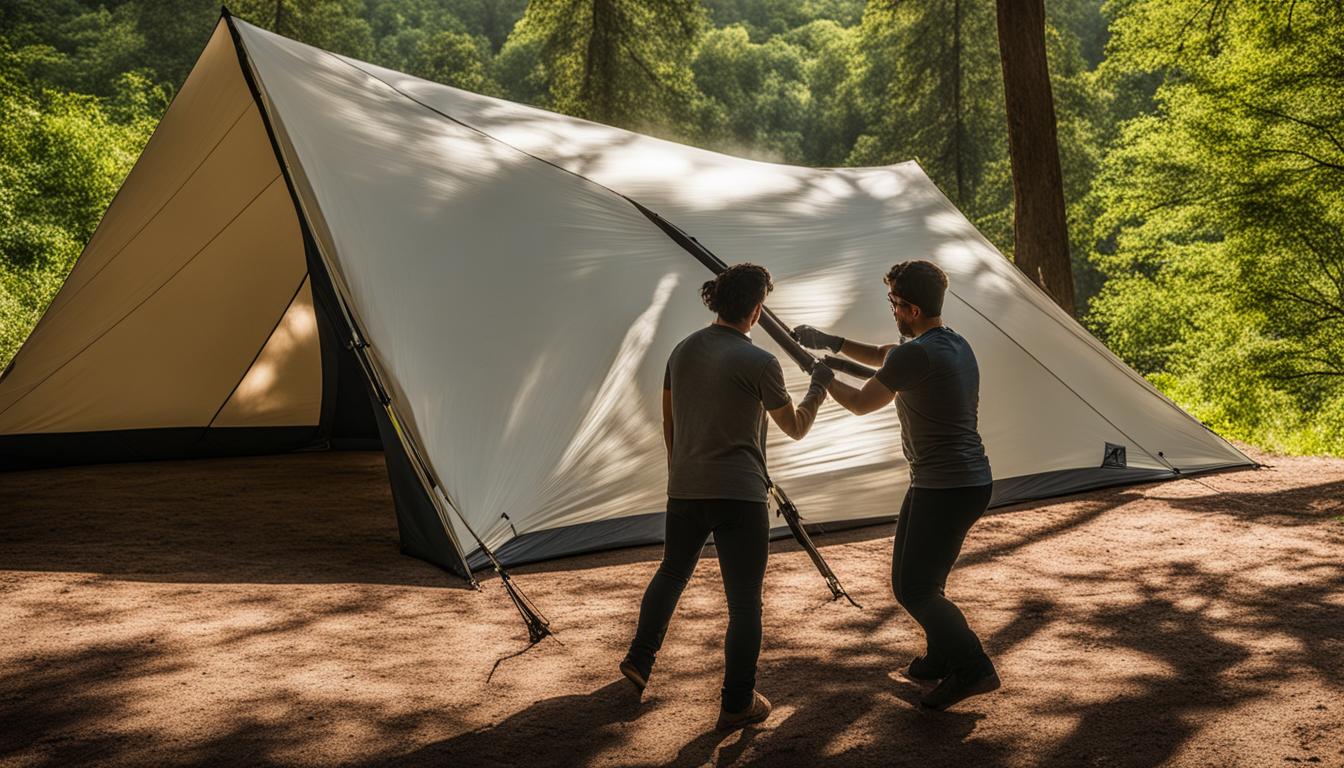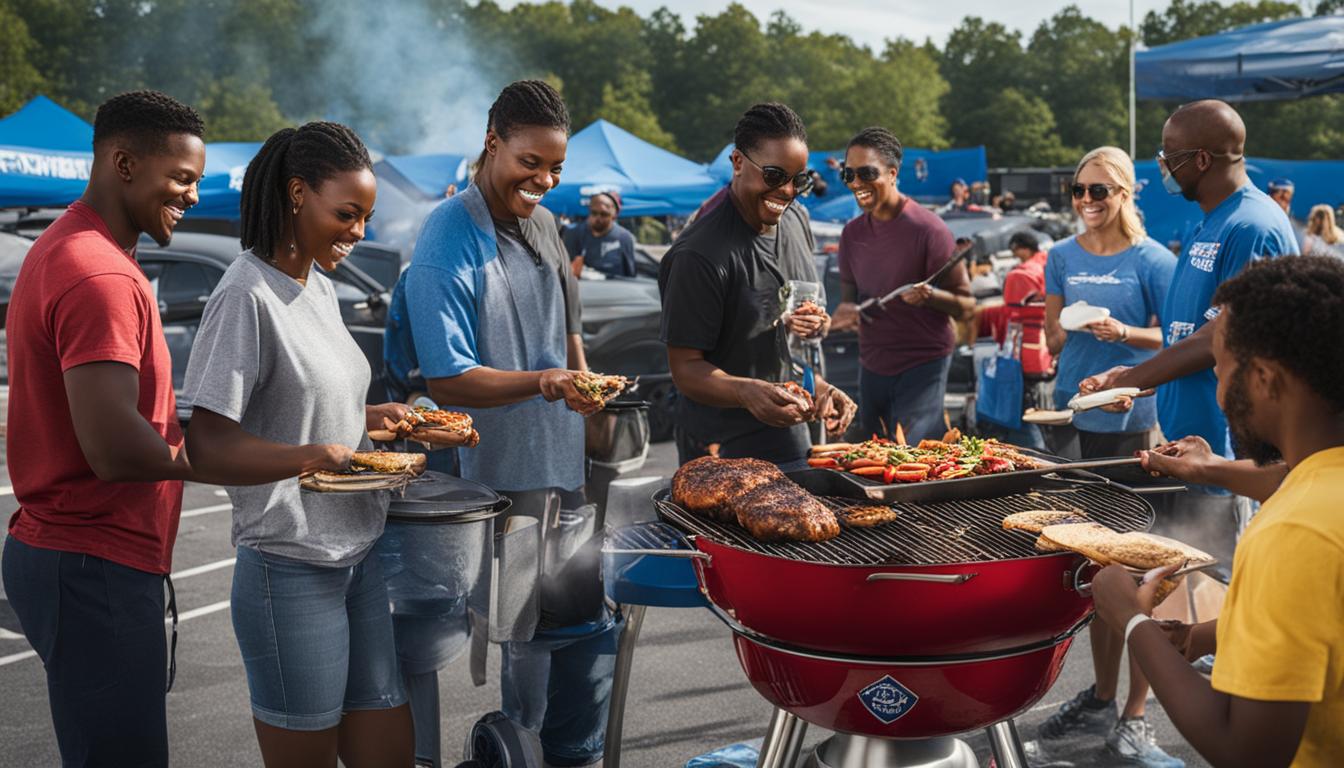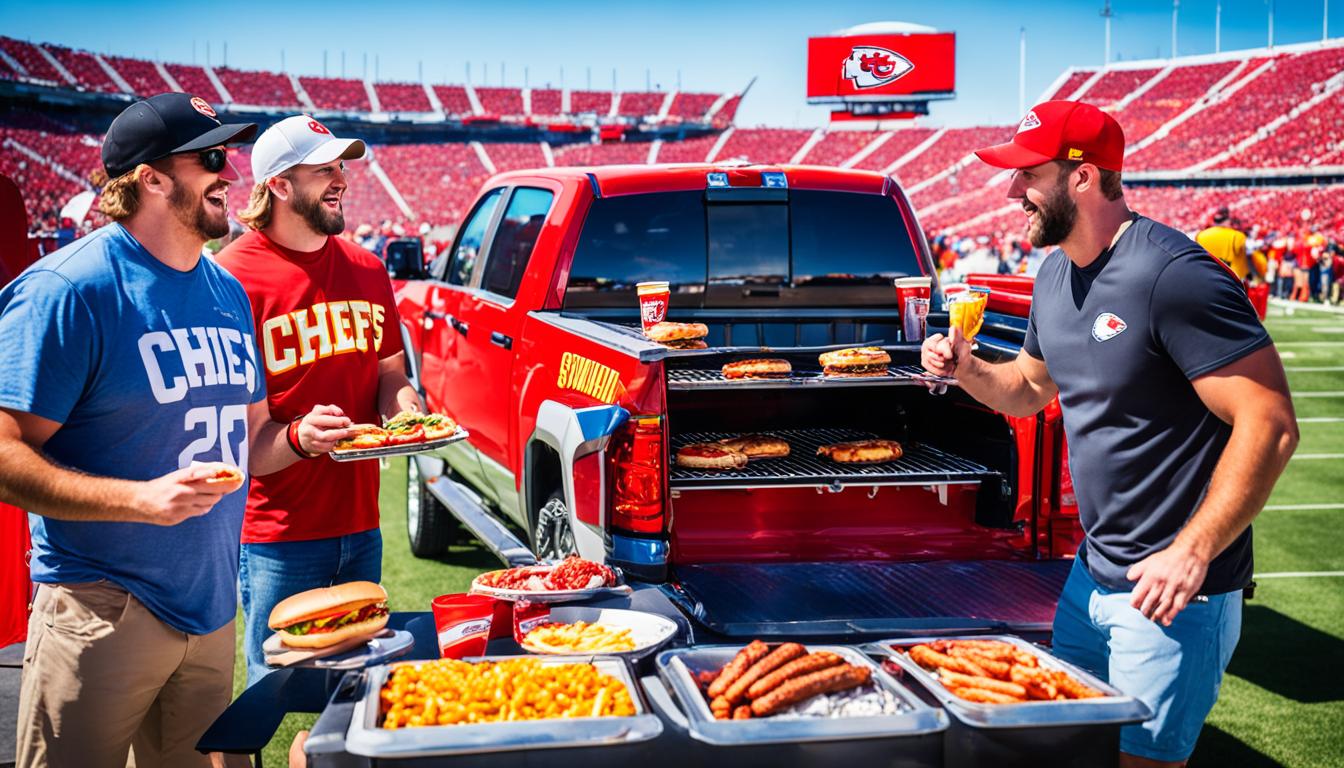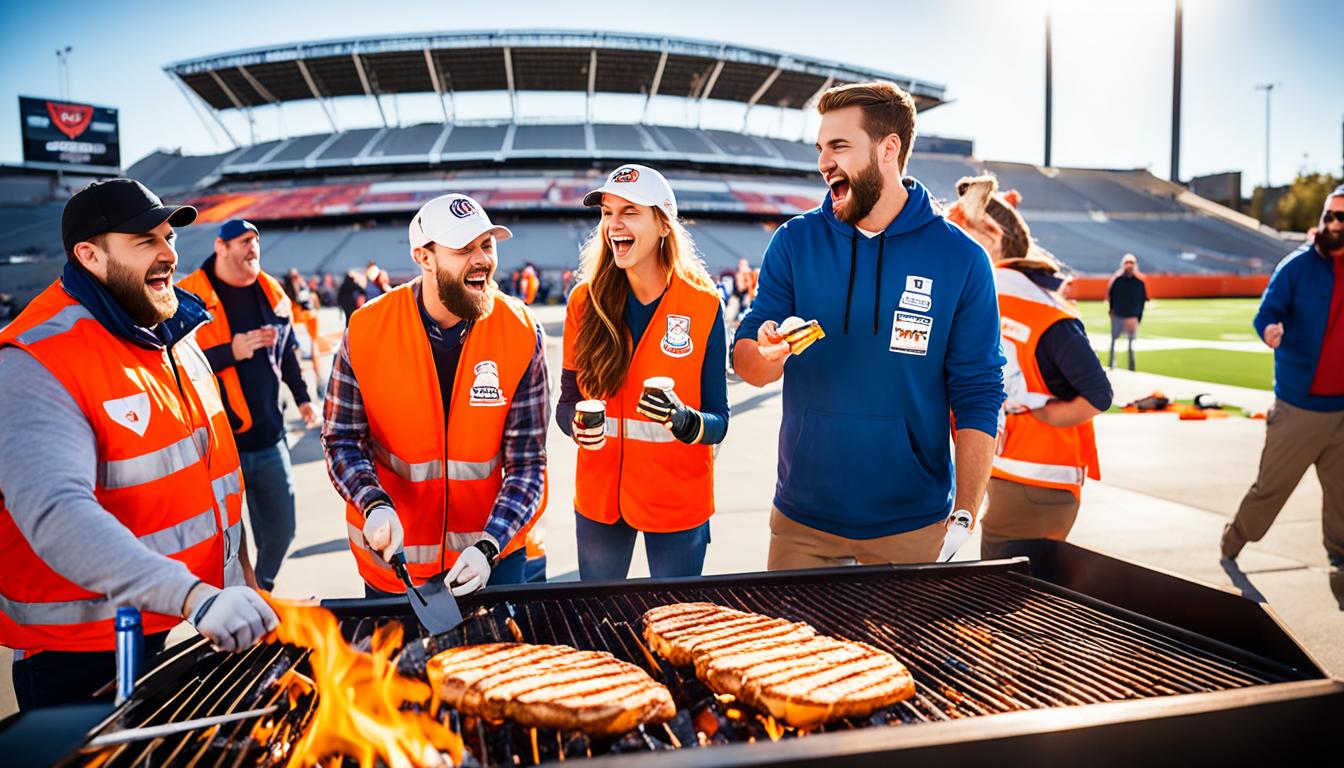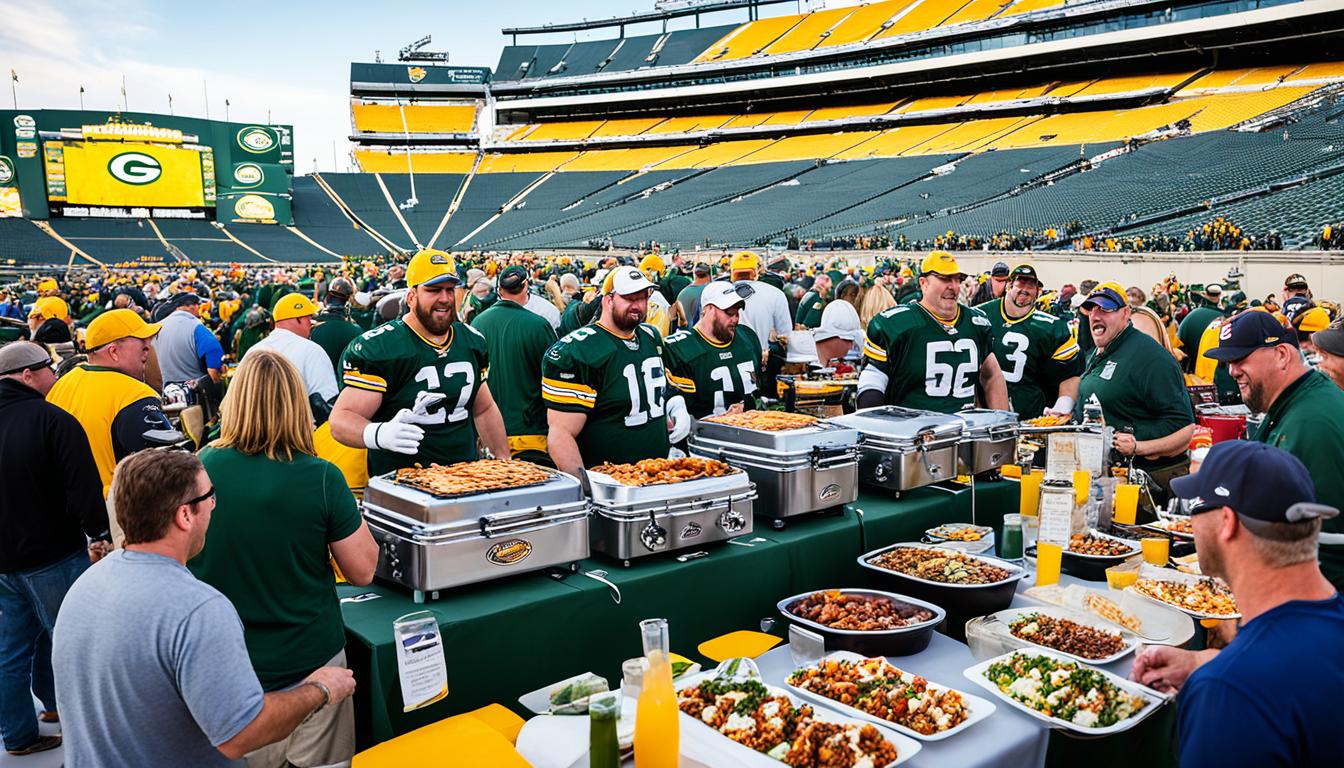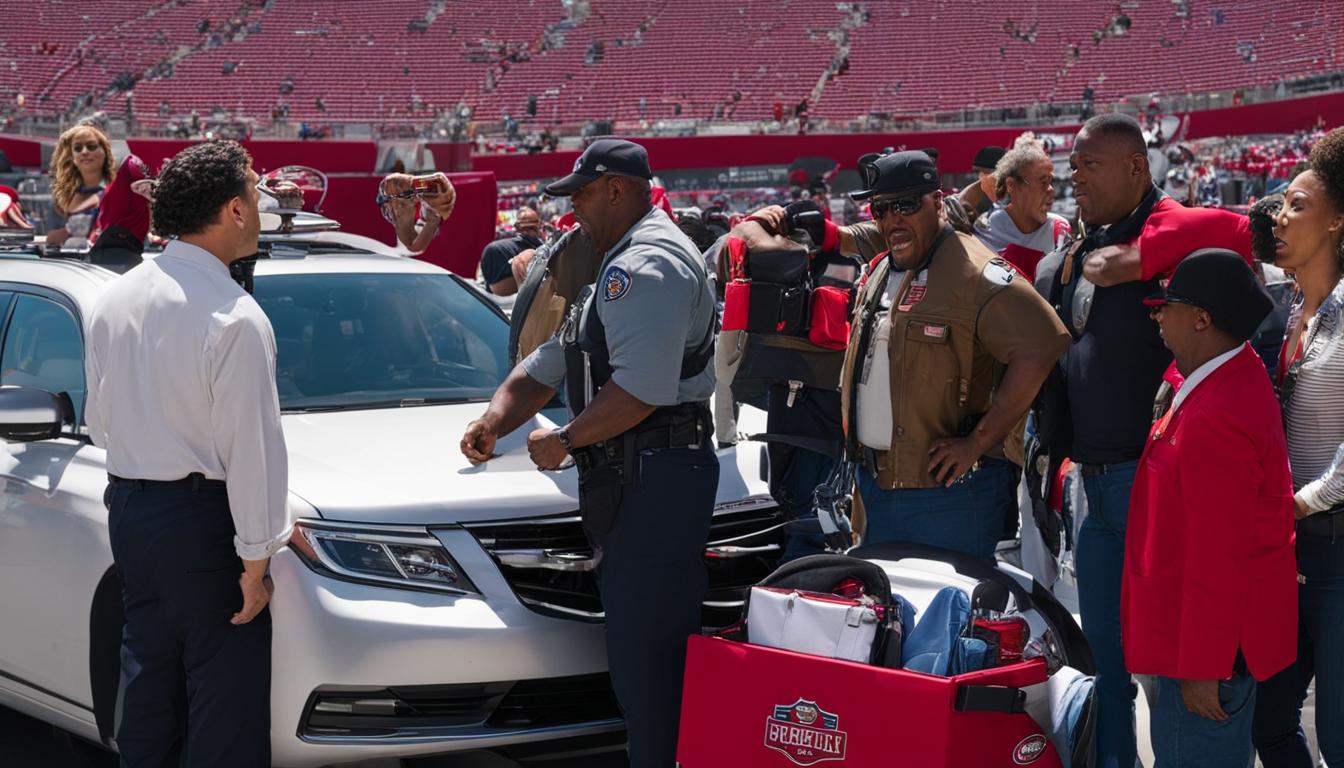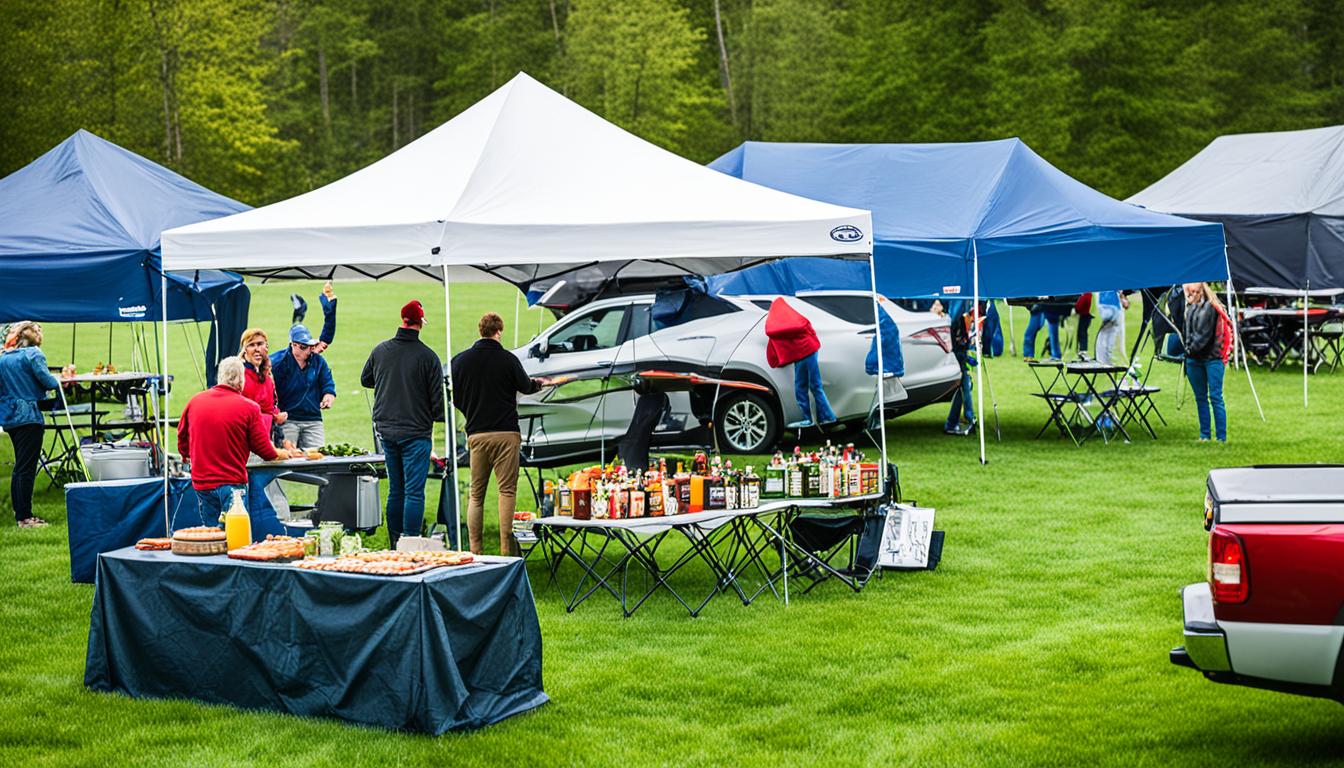
Tailgating is a beloved American pastime, whether you’re cheering on your favorite sports team or enjoying a concert with friends. To make the most of your tailgating experience, it’s essential to have a reliable and durable tent that can provide shade and protect you from unpredictable weather. In this Tailgate Tent Guide, we’ll explore the key factors to consider when choosing a tailgate tent, popular options in the market, and tips to enhance your overall tailgate setup.
Key Takeaways
- Invest in a portable tailgate tent that is sturdy, durable, and easy to set up.
- Consider factors like size, waterproofing, and dust-proofing when selecting a tent.
- Canvas tents, such as the Kodiak 10’x14′ and the Shiftpod 2, are popular choices for their durability and ability to withstand high winds.
- Shade is crucial for a comfortable tailgating experience, explore options like carport-style structures, monkey huts, and shade cloth.
- Stay cool in your tent with battery-powered fans, swamp coolers, or air conditioners depending on your power source.
What’s Important in a Tailgate Tent?
When it comes to choosing a tailgate tent, there are several key factors to consider in order to find the best tailgate tent that suits your needs. The top tailgate tents are not only durable but also provide the necessary features for a comfortable and enjoyable tailgating experience. Let’s explore the essential elements that make a tailgate tent stand out from the rest.
1. Sturdiness: One of the most important aspects of a tailgate tent is its sturdiness. You want a tent that can withstand strong winds and remain stable throughout your tailgating event. Look for a tent with a sturdy metal frame and reinforced corners that can hold up in challenging weather conditions.
2. Size: Tailgate tents come in various sizes, so it’s essential to consider the size that will best suit your needs. While smaller tents may be more portable, many tailgaters prefer tents that provide standing room and ample space for furniture and equipment.
3. Waterproofing: A durable tailgate tent should be made from waterproof materials to keep you and your belongings dry during unexpected rain showers. Look for tents with waterproof coatings and sealed seams to ensure maximum protection against moisture.
4. Dust-proofing: In addition to protecting against rain, a reliable tailgate tent should also be dust-proof. This is especially important if you’re tailgating in dusty environments such as parking lots or open fields. Dust-proof tents have tight-weave fabrics that prevent dust particles from entering the tent.
5. Zippers: Good-quality zippers are often overlooked but essential for a durable tailgate tent. Weak or flimsy zippers can easily break or jam, compromising the integrity of the tent. Invest in a tent with strong, corrosion-resistant zippers that operate smoothly.
By considering these factors, you can ensure that you choose the best tailgate tent that combines durability, size, waterproofing, dust-proofing, and reliable zippers. Now that we’ve discussed the important elements in a tailgate tent, let’s explore some popular options in the next section.
Popular Tailgate Tent Options
When it comes to selecting the perfect tailgate tent, two options stand out: the Kodiak 10’x14′ tent and the Shiftpod 2. Let’s take a closer look at these popular choices and their key features.
The Kodiak 10’x14′ tent:
The Kodiak tent is renowned for its exceptional sturdiness and outstanding quality. Crafted with durability in mind, this tent is designed to withstand various weather conditions, including wind and rain. Its waterproof and dust-proof features ensure that you stay dry and comfortable during your tailgating adventures.
Setting up the Kodiak tent is a breeze, thanks to its user-friendly design. You’ll appreciate the convenience of the overhead storage net that allows you to keep your gear organized and within reach. With its spacious interior, this tent provides ample room for you and your fellow tailgaters.
The Shiftpod 2:
If you’re looking for a tent that combines easy setup with a generous interior space, the Shiftpod 2 is an excellent choice. Inspired by portal pop-up ice-fishing shelters, this tent offers hassle-free assembly, allowing you to spend more time enjoying the tailgate festivities.
Although the Shiftpod 2 comes with a higher price tag compared to the Kodiak tent, its spacious interior makes it worth considering. Whether you’re hosting a large group or simply crave extra room, this tent delivers on space and comfort.
Both the Kodiak 10’x14′ tent and the Shiftpod 2 have their own unique advantages and considerations. When making your decision, think about your specific needs and budget to ensure you invest in the tailgate tent that ticks all the right boxes for you.
Staying Shaded at Your Tailgate
Providing shade is crucial for a comfortable tailgating experience. When the sun is beating down, having a shaded area can make all the difference. Here are some popular shade options for tailgating:
Metal-Frame Carport Canopies
Carport-style structures are sturdy and provide ample shade for your tailgate setup. They are designed to withstand wind and offer a durable solution for extended periods of use. However, these canopies require more setup and transportation hassle compared to other shade options.
Monkey Huts
If you’re looking for a shade option that is as good as or even better than carports, monkey huts are worth considering. These DIY structures offer excellent shade coverage and can be easily assembled and disassembled. They are lightweight and portable, making them convenient for tailgating events.
Shade Cloth and Aluminet
For a more portable shade option, shade cloth and aluminet are popular choices. These lightweight fabrics provide shade and reflect energy from the sun, keeping your tailgate area cool and protected. They are easy to transport and can be quickly set up and taken down.
Each shade option has its advantages, so it’s important to choose the one that best meets your needs and preferences. Consider factors like ease of setup, portability, and the level of shade coverage required for your tailgating activities.
| Shade Option | Pros | Cons |
|---|---|---|
| Metal-Frame Carport Canopies | Sturdy and durable | More setup and transportation hassle |
| Monkey Huts | Portable and easy to assemble | Requires DIY construction |
| Shade Cloth and Aluminet | Portable and lightweight | May provide less shade coverage |
Cooling Your Tailgate Tent
Staying cool in your tailgate tent is crucial, especially during those scorching hot days. Luckily, there are several cooling options available to help you beat the heat and stay comfortable while enjoying your outdoor adventures. Here are some cooling options to consider:
Battery-Powered Fans
If you’re looking for a portable and efficient way to cool down, battery-powered fans are a great choice. These compact accessories can provide a refreshing breeze and help circulate the air inside your tent. Whether you opt for a handheld fan or a tabletop model, battery-powered fans offer convenience and ease of use.
Swamp Coolers
Another cooling option to consider is a swamp cooler, also known as an evaporative cooler. These devices work by utilizing moisture and evaporation to provide a cooling effect. You can either purchase a ready-made swamp cooler or even make one yourself. With a bit of DIY know-how, you can construct a cost-effective swamp cooler that can help keep your tent cool and comfortable.
Air Conditioners
If you have access to an electrical connection, using an air conditioner for your tailgate tent can provide the ultimate cooling experience. Portable air conditioners designed for camping can be a bit pricier, but they offer powerful cooling capabilities. Keep in mind that using an air conditioner will require a reliable power source, so plan accordingly if you decide to go this route.
“Staying cool in your tailgate tent is important for a comfortable and enjoyable outdoor experience. Consider battery-powered fans, swamp coolers, or even air conditioners to beat the heat.”
When choosing a cooling option for your tailgate tent, it’s essential to consider factors such as portability, power source availability, and personal preferences. Whether you opt for fans, swamp coolers, or air conditioners, staying cool will ensure a pleasant tailgating experience.
Securing Your Tailgate Tent
Properly securing your tailgate tent is crucial to prevent any damage or displacement caused by strong winds. By using the right tools and techniques, you can ensure that your tent remains stable and secure throughout your camping experience.
Tent Stakes for Ground Anchoring
One of the essential components for securing your tent is using tent stakes to anchor it to the ground. Tent stakes provide stability and prevent your tent from being blown away. When choosing tent stakes, opt for durable steel stakes that can withstand various weather conditions. These stakes provide excellent grip and keep your tent securely in place.
Lag Screws for Added Stability
In addition to tent stakes, another option for securing your tent is using lag screws. Lag screws offer a strong hold and are easy to use. With their large threads and sharp tips, they can provide added stability, especially in areas with softer or looser ground. Simply screw the lag screws into the ground at an angle, ensuring a tight fit, and attach them to your tent’s anchor points for a secure setup.
Canopy Weights for Hard Surfaces
When setting up your tent on concrete or asphalt, using canopy weights is an effective way to provide stability. Canopy weights are designed specifically for hard surfaces and can prevent your tent from shifting or tipping over. These weights are typically made of heavy-duty materials like steel or cast iron and can be attached to the legs of your tent to keep it securely in place.
Remember to choose the securing method that is suitable for the specific terrain and weather conditions you’ll be camping in. By properly securing your tailgate tent, you can enjoy a worry-free camping experience and ensure the safety of both your tent and yourself.
Keeping Your Tailgate Tent Organized
Keeping your tailgate tent organized can greatly enhance your camping experience. By implementing effective tent organization tips and utilizing smart camping storage solutions, you can maximize space, easily locate your belongings, and create a more enjoyable and stress-free environment.
Tent Organization Tips
To make the most of your tent space, consider the following tent organization tips:
- Use tubs or plastic drawers: Utilizing storage containers can help keep your belongings organized and maximize available space. Store items in labeled tubs or plastic drawers to easily find what you need.
- Keep frequently-used items near the entrance: Place frequently-used items, such as cooking utensils, sunscreen, or bug repellent, near the entrance of your tent for easy access. This will save you time and effort searching for essentials.
- Utilize a camping bed frame: A camping bed frame with built-in storage compartments can help keep your sleeping area organized and dust-free. You can store items like clothing, shoes, or extra blankets underneath the bed frame.
- Protect your air mattress and pillows: Place a simple sheet or mattress cover over your air mattress and pillows to protect them from dust or dirt. This will help keep your bedding clean and extend its lifespan.
Smart Camping Storage Solutions
Investing in camping storage solutions can improve the overall organization and functionality of your tailgate tent. Consider the following options:
- Hanging organizers: Hanging organizers with multiple pockets can be hung from the tent ceiling or walls to store smaller items like flashlights, phones, or keys. This will keep these essentials within reach while saving valuable floor space.
- Shoe storage bags: Clear shoe storage bags can be hung inside the tent to keep your shoes organized and easily accessible. Plus, they help prevent dirt and mud from spreading throughout the tent.
- Collapsible storage bins: Collapsible storage bins are portable and convenient for storing larger items like camping cookware or extra blankets. When not in use, they can be folded down and easily stored.
- Campsite-specific storage solutions: Depending on the layout of your campsite, you can make use of storage solutions like collapsible clotheslines or hooks to hang wet towels, bathing suits, or camping gear.
By implementing these tent organization tips and using practical camping storage solutions, you can ensure a well-organized and enjoyable camping experience. A clutter-free tent will provide a relaxing space for you and your fellow campers, allowing you to fully immerse yourself in the joys of nature.
| Tent Organization Tips | Camping Storage Solutions |
|---|---|
| Use tubs or plastic drawers | Hanging organizers |
| Keep frequently-used items near the entrance | Shoe storage bags |
| Utilize a camping bed frame | Collapsible storage bins |
| Protect your air mattress and pillows | Campsite-specific storage solutions |
Tips for Setting Up Your Canopy Tent
Proper setup of your canopy tent is essential for its stability and longevity. Whether you’re preparing for a camping trip or setting up a shade structure for an outdoor event, following the right setup protocol will ensure a hassle-free experience. Here are some canopy tent setup tips to help you get started:
- Check the frame: Begin by partially expanding the frame of your canopy tent. Make sure each leg is set to the same height, ensuring stability and balance.
- Gradually expand: Slowly expand the tent to its full size, keeping an eye on any tie-downs or Velcro fasteners that may need adjustments along the way.
- Choose the right location: Set up your tent on even ground with short grass or semi-firm soil for staking, ensuring a solid foundation for your canopy tent.
- Consider tent weights: If you’re setting up your tent on concrete or asphalt, tent weights can be used instead of stakes to provide stability. Make sure to secure the weights properly.
By following these canopy tent setup tips, you can ensure a secure and reliable setup that will withstand various weather conditions. Take the time to properly set up your canopy tent from the beginning, and you’ll avoid complications and enjoy a comfortable outdoor experience. Now, let’s take a look at the different ways you can secure your canopy tent on different types of terrain.
Proper Canopy Tent Setup: Step-by-Step Guide
-
- Partially expand the tent frame.
Ensure each leg is set to the same height.
Gradually expand the tent to its full size.
Double-check tie-downs and Velcro fasteners.
Set up the tent on even ground with short grass or semi-firm soil for staking.
If setting up on concrete or asphalt, use tent weights instead of stakes.
Securing Your Canopy Tent on Different Terrain
The terrain you set up your canopy tent on can significantly impact its stability. It’s crucial to choose a location with even ground and avoid areas with water, trees, or bushes that can potentially damage the tent. Tent stakes are commonly used to secure the tent to the ground, but staking the tent on uneven or soggy ground can make it more susceptible to damage or toppling over. If you’re setting up your canopy tent on concrete or asphalt, alternative securing methods like using tent weights are necessary to provide stability.
When securing your canopy tent, here are a few tips to consider:
- Choose a location with even ground and remove any debris that may compromise the tent’s stability.
- Inspect the area for potential hazards like water, trees, or bushes that can damage the tent.
- Use sturdy tent stakes to anchor the tent on firm ground whenever possible.
- If staking is not an option, consider using tent weights or sandbags to provide stability on concrete or asphalt surfaces.
- Ensure the tent is properly tensioned and all ropes, straps, or fasteners are securely tightened.
Securing Canopy Tents on Different Terrain
Staking a tent on uneven ground or soggy terrain may not provide the necessary stability to withstand winds or other environmental factors. In such situations, alternative securing methods are required:
“When camping on uneven ground or setting up a canopy tent in areas with poor soil conditions or excessive moisture, traditional tent stakes may not be sufficient. In some cases, using lag screws or anchors can provide better stability and peace of mind.”
Using lag screws involves drilling screws into the ground or securing them to nearby structures, ensuring a more robust and reliable anchor. This method is particularly useful when setting up a canopy tent on rocky or hard surfaces.
Another approach to securing a canopy tent on different terrain is using tent weights or sandbags. These portable and adjustable weights can be placed on the tent’s legs, counterbalancing the forces and providing stability on concrete or asphalt.
| Terrain Type | Securing Method |
|---|---|
| Even Ground with Strong Soil | Tent Stakes |
| Uneven or Soggy Ground | Tent Stakes + Lag Screws or Anchors |
| Concrete or Asphalt Surface | Tent Weights or Sandbags |
| Rocky or Hard Surfaces | Lag Screws or Anchors |
Remember, properly securing your canopy tent on different terrains ensures its stability and reduces the risk of damage from unpredictable weather conditions or accidental tipping.
Adding Extra Reinforcement to Your Canopy Tent
In situations where you need to enhance the stability of your canopy tent, tent anchors are a valuable solution. These durable straps are designed to be fastened to your tent’s frame and then attached to a stabilizing object nearby, such as stakes or weighted barrels.
Tent anchors play a crucial role in balancing tension and providing extra reinforcement, particularly in areas with strong winds or rowdy crowds. By strategically attaching the anchors to your tent’s frame, you can prevent any excessive pulling in a single direction, ensuring overall stability.
Adding tent anchors to your canopy tent not only adds extra stability but also provides you with peace of mind during your outdoor activities. With the added reinforcement, you can enjoy your time without worrying about your tent being blown away or compromised by challenging weather conditions.
With tent anchors, you can secure your canopy tent in various environments, allowing you to focus on enjoying yourself rather than constantly worrying about the tent’s stability. Whether you’re camping in a windy area or attending a bustling outdoor event, tent anchors can provide the support you need.
Protecting Your Canopy Tent from Water Damage
Water damage can be a significant concern for your canopy tent, as it can lead to rusting of frames and the growth of mold in fabric roofs and sides. To prevent these issues and keep your tent dry, it’s crucial to invest in water-resistant materials and canopy tent accessories.
Invest in Water-Resistant Materials
To effectively prevent mold and maintain the integrity of your canopy tent, opt for water-resistant materials like vinyl for the roofs and sides. Vinyl is known for its excellent water resistance, ensuring that no moisture seeps through and causes damage. By choosing a canopy tent with water-resistant materials, you can enjoy peace of mind and a dry camping experience, even in wet conditions.
Additional Accessories for Water Damage Mitigation
Aside from using water-resistant materials, there are other canopy tent accessories that can help mitigate water damage. Consider these options:
- Extra Sides: Adding extra sides to your canopy tent can provide an additional layer of protection against rain and prevent water from entering through the sides.
- Rain Gutters: Installing rain gutters along the edges of your canopy tent can channel water away and help prevent it from pooling on the roof, reducing the risk of leaks and water damage.
- Tent Flooring: Using tent flooring or a ground tarp can help create a barrier between your tent and the wet ground, preventing moisture from seeping through the floor and causing damage.
Transportation and Storage Considerations
Carrying cases for canopy tents are essential for protecting your tent during transportation, especially in inclement weather. Ensure that your carrying case is made of sturdy, water-resistant material to keep your tent dry while on the move. This extra layer of protection can help prevent water from seeping into the fabric and causing damage to your tent.
It’s important to prioritize high-quality canopy tent materials and accessories to safeguard against water damage. By taking these steps to protect your canopy tent, you can extend its lifespan and enjoy camping adventures without worrying about potential water-related issues.
| Canopy Tent Accessories | Benefits |
|---|---|
| Water-resistant vinyl roofs and sides | – Prevents mold and keeps the tent dry – Exceptional water resistance |
| Extra sides | – Adds an extra layer of protection against rain – Prevents water from entering through the sides |
| Rain gutters | – Channels water away from the roof – Reduces the risk of leaks and water damage |
| Tent flooring or ground tarp | – Creates a barrier between the tent and wet ground – Helps prevent moisture from seeping through |
| Sturdy carrying cases | – Protects the tent during transportation – Keeps the tent dry in inclement weather |
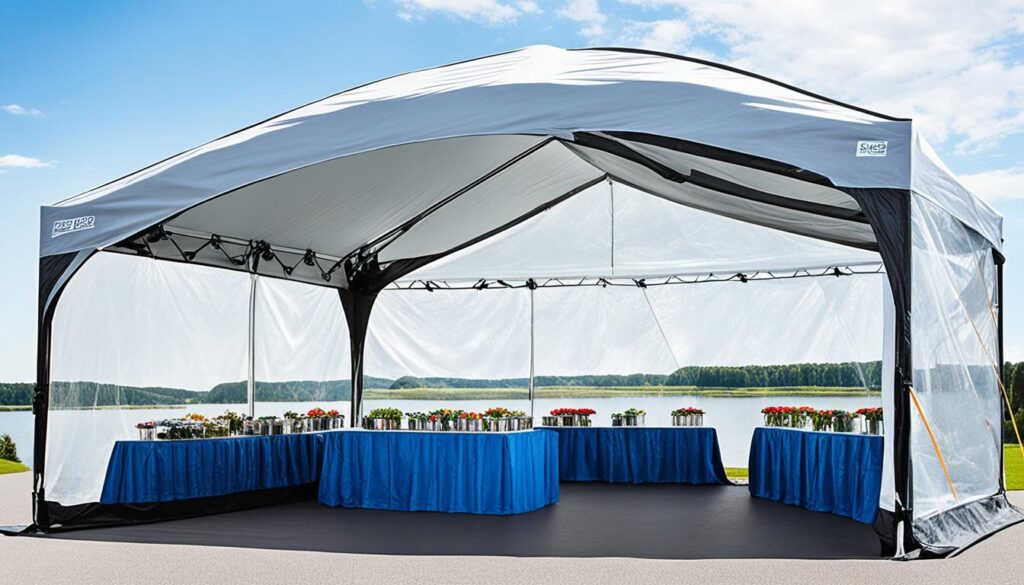
Conclusion
Tailgate tents are an essential accessory for outdoor enthusiasts looking to stay shaded and dry during events. When selecting a tent, it is crucial to prioritize factors such as sturdiness, size, waterproofing, and dust-proofing to ensure a comfortable and enjoyable experience.
Providing shade is paramount when tailgating, and options like carport-style structures, monkey huts, shade cloth, and aluminet can help protect your tent from the sun’s heat and harmful rays. Coupled with cooling solutions like fans, swamp coolers, and air conditioners, you can create a comfortable environment even on hot days.
To ensure your tent remains secure, invest in sturdy tent stakes or lag screws to anchor it to the ground. On harder surfaces like concrete or asphalt, canopy weights can provide stability and peace of mind. Proper organization and storage solutions like plastic tubs or drawers can help keep your belongings organized and maximize space inside the tent.
By following these guidelines and investing in high-quality materials and accessories, you can enjoy your tailgating adventures with confidence and peace of mind. So, get ready to elevate your tailgate experience with the perfect tailgate tent, and make lasting memories with family and friends.

Ryan Conlon is a passionate football fan and the driving force behind “Home Tailgate Party.” Ryan’s love for the game, combined with his culinary expertise, has led to a treasure trove of game day recipes and strategies. Whether you’re a seasoned tailgating pro or a rookie looking to up your game, Ryan’s insights and delicious recipes will help you score big at your next tailgate.

